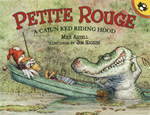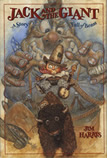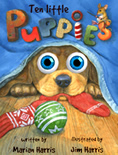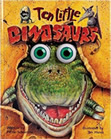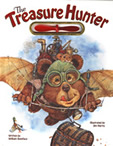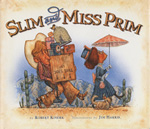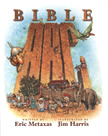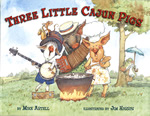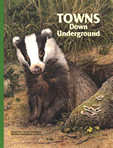Jim Harris Talks About Illustrating…

The Tortoise and the Jackrabbit
Tortoise and the Jackrabbit was a lot of fun to illustrate. It’s a desert version of the old Tortoise and the Hare fable, with a very cocky Jackrabbit and a very wise Tortoise.
When I first read the manuscript for this book, I knew the desert would have to look totally believable. I got this image in my head of a really hot, really dry, really Arizona desert. We’re talking wide-open sand. Lots of saguaros. Desert poppies and verbena blooming up everywhere. And bright blue sky.
(And mountains in the distance, of course.)

So how to re-create this with paint?
Well, here are a few little techniques I used…
USING FRISKET TO CREATE A BACKGROUND SKY
For the sky I wanted that intense clear-blue-forever feel. So first thing in these cases, I get out my frisket. (Frisket comes in sheets or in liquid, but the sheets worked best for this book.)
Step one, I lay the frisket over the pencil sketch that I’ve already drawn.
The frisket sticks to the paper like a huge sheet of tape, but it doesn’t damage the paper when you pull it off later. So, if you’re getting the idea here, I’m putting a paint-repellant plastic layer of frisket over my whole sketch. Then I use a craft knife to slice away the frisket in the area that I DO want to get blue-sky paint on. And I leave covered with frisket all the parts of the painting that I definitely DON’T want to get blue on (like Roadrunner who’s busily putting out race-day signs.)

Then out comes the airbrush, I gas it up with fresh paint, then buzz, buzz, swish, swish, and a bright blue oval (or whatever shape seems appropriate) of paint appears on my paper . I make sure when I’m applying it that it fades out on the edges and I’m done! At this stage it looks like I’ve painted blue all over my character and my mountains, but no fear! Once the blue is nice and dry, I gently lift off the frisket and presto! There’s pure paper-white where I’m going to paint Roadrunner and his desert home.
So that’s one trick.
By the way, if you’ve never used frisket, it’s not very expensive. You can get a couple sheets or a little bottle at the art store. When you get it home, experiment around with carving out frisket shapes on a piece of paper and painting over and around them (it works with regular brushes just as well as with an airbrush), and then lifting the frisket to see what you’ve created.
If you get the liquid frisket, try spattering some of it across a paper, then painting blowsy green grass around the spatters, then lifting the frisket and filling in the “holes” (where the frisket was) with saturated colors to make wild flowers peeking out from the grass. Dab in a few stems under the flowers and WOW… how do you like THAT!!!
Anyway, that brings up another good trick, namely Saturated Colors.
PAINTING WITH SATURATED COLORS

First, do you know what a “saturated color” is? It’s a “pure” color. Very little black mixed into it, if any.
Obviously then, an UN-saturated color is one that DOES have some black mixed in, sometimes a lot. We say it’s “grayed down.”
In Tortoise and the Jackrabbit, I used saturated and un-saturated colors to do two opposite things.
Here’s a painting where I used UN-saturated color to make something look far away. Un-saturated colors tend to do that.

See how the mountains look more gray than the foreground colors? I did that on purpose to throw them into the distance.
And I purposely used saturated yellow, red and green to pull the cactus in the foreground right up close into your personal zone. Careful! Those spines are SHARP!

Here’s one of my favorite paintings from Tortoise and the Jackrabbit. Susan Lowell’s text described this scene as dusty… flat… and hot. So I airbrushed in some clouds of flying sand and used lots of dusty brown.

But it needed something to give it life! What could it be?
I know… a spot of saturated color!
See it?
It’s the pink on Ms. Tortoise’s hat and purse. Saturated colors work well that way—
just a spot or two, and a bland scene comes roaring to life.
Mostly I like that mean old car, though. In the story he doesn’t really run Ms. Tortoise over. She’s too tough for that… but he gives it a good try.
You’ll have to check Tortoise and the Jackrabbit out of your library and see how it all turns out.
Happy reading! (And painting!)


